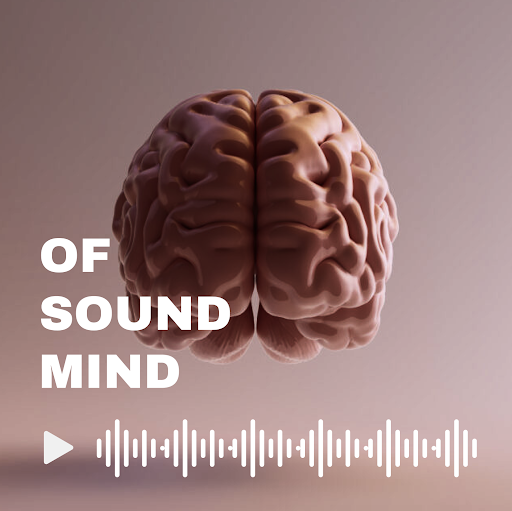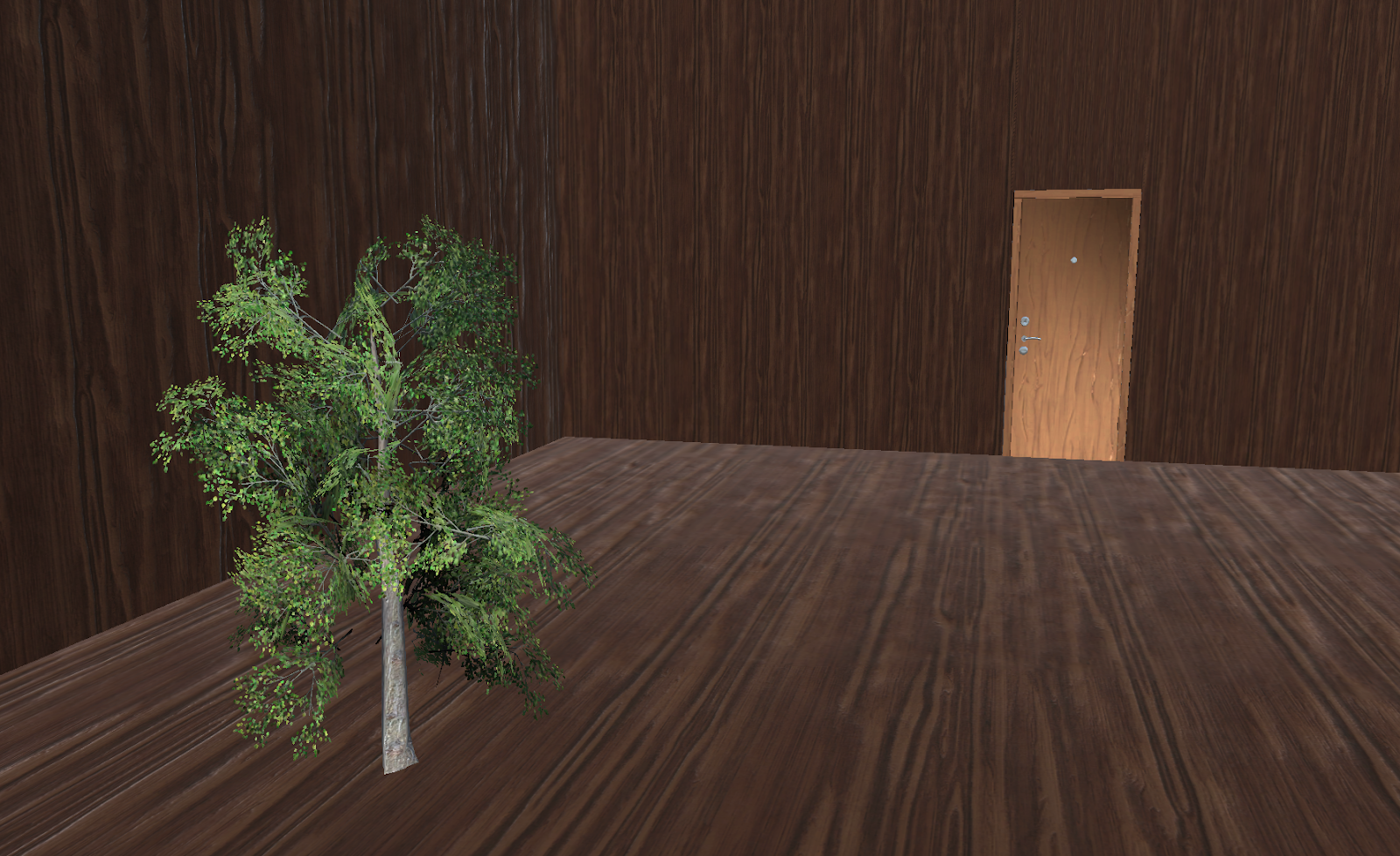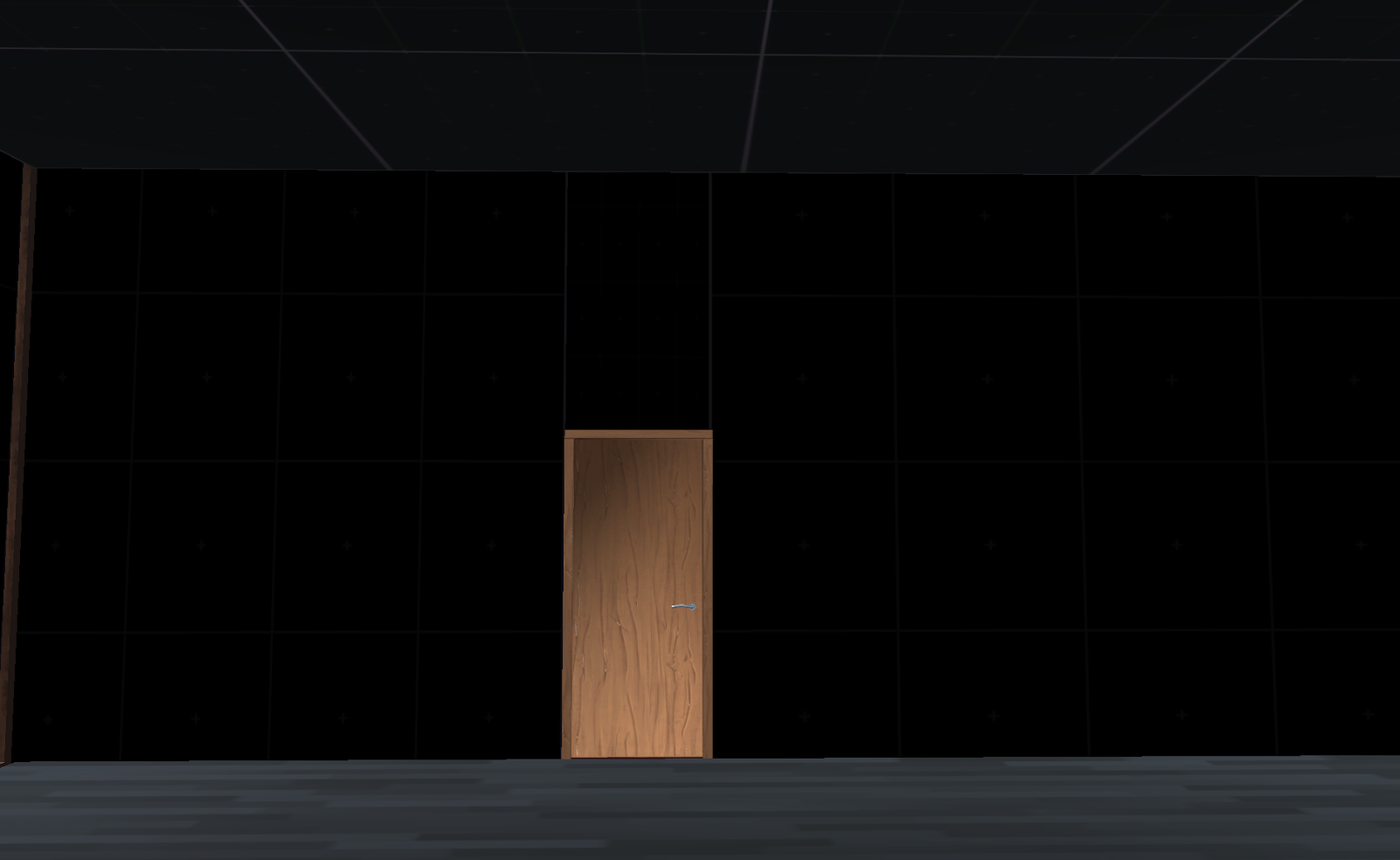
Created by: Winston Liao, Emily Zhong, Dante Zhu, Angela Zhang, Hana Tadesse
Artist’s Statement
Of Sound Mind is a single-player audio-based narrative puzzle game in which a player is dropped into a room or “mind palace” and is tasked with piecing together their most recent but forgotten memory. To do so, the player must explore different rooms and listen to audio clips corresponding to the memory associated with that room. Through listening and replaying audio clips in various orders, the player pieces together their most recent memory. The player ultimately finds that the audio clips are describing the actions of the player and they have committed a terrible crime, revealing them as the villain of the game.
In Of Sound Mind, we endeavored to create an immersive game experience that revolves around two primary game dynamics/themes: First, we wanted to design an audio-based game, in contrast to typical visual-driven games. Audio can frequently enhance immersion into a game and evoke emotions/engagement that drives the narrative of the game. Second, we endeavored to create a game in which the player is the anti-hero or villain, but does not learn of this until they have “solved” the puzzle/game. We hope that a twist on the conventional game narrative would further engage the player and deliver a more powerful narrative.
The game’s target audience is those aged 18-24 who seek an immersive game experience delivered via an emotionally engaging unconventional narrative.
System Map

Overview of Game Narrative: Characters & Scope of Slice
Characters
Halo – the main character that the player plays as. They’ve recently gone through a traumatic event and are rediscovering the memories. In this slice, we reveal that there was a botched proposal incident with the woman, and it has potentially led to some incidents (explored post-slice).
Mind Palace Guide – the “guide” throughout the game. They manage the mind palace and are part of Halo (not revealed in the slice). They are currently reorganizing the Mind palace, trying to hide certain memories from Halo after the traumatic event, without seeming suspicious. Think Jerry from Soul.
Woman – The Woman is the lover of Halo. Halo decided to propose to her some days before the accident. She rejects Halo’s proposal and leaves.
Scope of Slice
By the end of the slice, the player will have heard the entirety of the Woman’s dialogue(s). Snippets of the dialogue get revealed as the player explores different rooms in the environment. Each room includes an audio recording that builds off of the previous audio clip(s) and reveals some characteristics of Halo to help them piece together the forgotten memory.
The dialogue, along with the setting, reveals that Halo has proposed to the woman, but the woman unexpectedly rejects this proposal. Issues with Halo / the relationship are revealed — alcoholism, thievery, etc. The ending suggests that something bad happened to the woman that would be uncovered in future scenes. We have omitted these scenes to contain the scope of our slice.
Moodboard

Analysis of Of Sound Mind
Formal Elements
Players
Of Sound Mind is structured as a single-player vs game, where the player is tasked with solving the puzzle of piecing together the randomly arranged events of a narrative. Initially, the player has just one role: explore the rooms, listen to the audio, and piece together the events of the narrative. However, as the player begins to solve the narrative puzzle, they realize that the audio clips are about the player, and the player has committed a crime; the player implicitly takes on a second role — one where the player needs to uncover what has happened in the memories.
Objective
The game has one objective: piece together the disjointed, randomly presented events to uncover what has occurred. This requires the player to explore the various rooms and audio clips; by discovering new findings of the main character and past events through revealing new audio clips, the players will solve the narrative puzzle.

Rules, Procedures, and Actions
We endeavored to have few rules to focus the game on exploration. Listed below are the rules, procedures, and actions:
-
- The player uses their mouse or track-pad to change directions and gain an overview of the rooms. Pressing the ESC button reveals the mouse (action).
- The arrow keys (up, down, left, and right) are used to move towards and away from objects and doors (action).
- When a player approaches a door, the door will open, and they can walk through the door into another room (action).
- When a player enters a new room, they once again use arrow keys to explore objects.
- Typically, the player upon entering a new room will hear an audio clip. As they approach the source of the audio clip, the audio will become louder (action).
- The player is encouraged to listen to the audio clip until it finishes before leaving the room and exploring another room using steps 1-4.
- The player can listen to audio clips as many times as they would like, and in whichever order. Each time the player listens to the audio clips in a room, the main audio dialogue is updated to include more information that is relevant to the room’s audio clip.

Time
There are no time constraints, as we designed the game to give the player ample time to piece together the events of the narrative at their pace.
Conflict
There are two primary conflicts within the game. The first being the obstacle of listening to the audio clips and making sense of them as the player pieces together what has happened. The second conflict is the internal conflict or dilemma the player encounters when they realize that the audio clips are about the player and the player’s generally negative characteristics.
Boundary
The boundaries of the game are explicit and apparent. The player is trapped in a “mind palace” composed of 4 small rooms where they can see the roof, ground, and walls. The confined boundaries were intentionally designed to convey the notion that the player is trapped and in solitary confinement–similar to being “in one’s head.”

Types of Fun
Narrative
The primary source of the fun in Of Sound Mind is uncovering the underlying narrative of the game. To deliver the narrative, we also utilize the elements of sensation via immersive sound, and exploration and discovery as the player travels to different rooms and uncovers various audio clips.
Sensation
One of the primary sources of fun in Of Sound Mind is the use of audio to engage the player to create an immersive experience. We employ three primary strategies to do so. First, audio clips become louder as you approach the source, as well as being directional, adding in spatial dimensionality, and recreating sound in real life. Second, we add background noise to audio clips to set the location of the audio clip. For example, in the bar audio clip, we add the background noise of loud chatter and glasses clinking. Third, we use sound rather than an explicit dialogue in audio clips to communicate what has happened. For example, in the jewelry audio clip, a loud crash is heard to indicate that the player has broken glass and stolen the ring.
Exploration and Discovery
There are four primary ways we have designed exploration and discovery as elements of fun for the game. First, the player has the freedom to explore and wander through the various rooms. In the initial exploration phase, the player does not know what to expect. All audio clips and objects discovered in each of the rooms are new to the player, and each audio clip conveys a small narrative. The player can listen to the audio clip multiple times to first comprehend the events in each isolated audio clip. The second source of discovery arrives when the player ventures into the different rooms to listen to the audio clips, but this time with purpose. The second phase of the game involves the discovery of how the audio clips relate to one another and contribute to the overall narrative. Third, through listening to the various audio clips, the player learns about the type of person their character is. The bar scene conveys that the protagonist deals with alcoholism and the jewelry scene conveys that the protagonist is a thief. This contributes to the final discovery–a “plot twist” where the player realizes that the audio clips are about them and they have committed a crime.

Challenge
The primary challenge of Of Sound Mind is figuring out the overall story behind the audio clips. We allow the player the freedom to choose the strategy they wish to employ to resolve this puzzle. They may employ logic through listening to the audio clips and attempting to use clues from each audio clip to place the clips in order. For example, “ring” is first mentioned at the jewelry store audio clip and then again at the bar audio clip, implying that one jewelry audio clip comes before the bar clip. The player can also employ trial and error as they listen to each audio clip multiple times for additional clues to place the sequential order. The game communicates clues through a bread crumbs approach where clues are hidden within each audio clip and audio clips are scattered around the mind palace.
Onboarding
Given that our game is a slice, we chose to focus more on the main gameplay mechanics (with the assumption that the final game would include more thorough onboarding for base actions) but included some onboarding to give players context for the story necessary to make the slice more complete.
The slice intentionally begins with the player suddenly appearing in an empty room with little instruction. In doing so, we hoped to create an atmosphere of confusion, suspense, anxiety–themes that parallel the game narrative. While this may seem like there is no onboarding in place, the onboarding in our slice occurs via the “mind palace guide” character. The mind palace guide introduces the player to the idea of “mind palace” and then informs the player of the goal of the game.
We designed the onboarding process so that the mind palace guide is blended into the game. Just as the player approaches various audio clips to learn of a narrative, the player also approaches the mind palace guide to learn about the game rules and objectives. This follows the strategy of the “get the player to do it once” strategy. Furthermore, we also “spread out the teaching/onboarding” by introducing the mind palace guide at various points throughout the game. All of these strategies allow onboarding to not disrupt the flow of the game.

Balance
Given that Of Sound Mind is a single-player game, the main concern for balance is the pace of the game. There were concerns that players may piece together the sequential order of the audio clips at different speeds–with some players understanding the narrative quickly, while others require multiple replays of audio clips to understand what has happened. We incorporate the mind palace guide at various parts of the game to deliver guidance and maintain a certain pace.
Playtesting and Iterations
Each of our playtesting sessions was conducted with at least 2 students from our class, and the three sets of playtests occurred a week apart.
Playtesting Session 1: Audio Visualizer & Audio Memory Test
Our first playtesting session tested whether players would react positively to navigating an audio-spacious environment, and how an audio-based game would impact the player’s memory and ability to retain information. So, we ran two different activities on our playtesters.
In the first activity, we used an existing audio-spatial environment online and had players navigate through that space and interact with the different audio sources. From this activity, we learned that physical/visual objects can be used to guide players to the audio source and help them focus on the task at hand. Playtesters also mentioned that the current starting experience on the website was overwhelming since multiple audio sources were playing all at once. This informed our decision to initiate the game with a single audio source playing and not confuse the player. Furthermore, playtesters confirmed that the website was very immersive despite being audio-focused, which was our goal of the game.
In the second activity, we read a dialogue between two characters and asked the players questions about the conversation to test their memory. We learned that the dialogue failed to provide enough context for the main character and the scene. This feedback influenced our decision to include the “mind palace guide” whose primary objective is to guide and situate the character in the game space. Playtesters also suggested introducing a feature that the player could use to replay the audio when needed. We received positive feedback on the audio-driven format of our game, some players stating that it made the experience more immersive as opposed to limiting it to only visuals.
We kept all these learnings in mind as we started building our game (not much was changed as our game had yet to be fleshed out at this point).
Playtesting Session 2: Gameplay
In the second playtest, we built out a demo version of the game in Unity with the character movement and first-person perspective controls. One room was implemented to test out the technical details of creating a physical space, triggering events based on the player’s location, and playing a set of audio dialogue. We also wanted to see whether the control scheme and feedback were intuitive for users. Beyond the technical bugs, users commented that they had a difficult time understanding and distinguishing characters’ voices and that the lack of visual indicators in the space made it hard to navigate. With this feedback in mind, we cut down the length of dialogue, included more people for voice acting, and added textures and objects to space.
Playtesting Session 3: Narrative Playthrough
In our third playtest, we took Laura’s advice and chose to focus on our story/scenes and make sure those are solid before incorporating them into our game. Thus, we playtested by narrating the story to players while simultaneously showing them the corresponding room. Players were able to “navigate” to the three other rooms (Barbershop, Christmas Market, & Local Pub) and hear the conversation. One of the first things we noticed was that players instinctively tried interacting with the object in the room and suggested that we align the audio with the object and use it as a guide. We also heard that they were confused about the function of the room since there were limited visual guides and no audio source to set the scene. Although the ending was a bit abrupt, both players felt that the story was clear and easy to follow. With the story concrete, we were able to incorporate the story/audio sources into the game.
Conclusion
Intending to create an experiential sound-based narrative, we successfully created a slice that represents the culmination of lots of ideation, playtesting, and development. We faced not only many technical challenges in Unity but also wrangled with the difficult format of a story-driven through audio. In creating Of Sound Mind, we exercised our understanding of fundamental game design concepts and cultivated an aesthetic of exploration, sensation, and narrative for players. From this experience, these were our main takeaways:
- Constructing an interactive mystery narrative is very difficult, especially when you as a creator understand the whole story from the beginning. It is a learning experience for the user is not only figuring out the game mechanics but also piecing together the story, so guidance, as well as onboarding, are paramount.
- Player memory and attention is a finite resource. This is quite ironic in a game about the malleability and fragility of memory, but we also came to recognize how much literal information players don’t retain. Learned actions and understanding of the world itself stick with the player more than anything else.
Gameplay
We integrated our playtesting findings into this final slice, which includes the Unity demo with the full three-room script, onboarding narrative experience, and voice acting.


